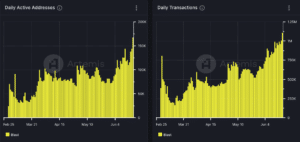Blast, an Ethereum layer 2 blockchain network, recorded all-time highs in daily transactions and active users on Thursday, ahead of its airdrop scheduled for June 26.
According to data from blockchain analytics firm Artemis, the number of wallet addresses active on Blast, a rough proxy for active users, more than doubled from roughly 73,500 addresses at the start of June to about 168,400 as of June 20.

The increase in active addresses coincided with an uptick in daily transactions as well. Users generated 640,1000 transactions on the first day of June. Since then, the number of transactions has grown almost 72% to 1.1 million transactions, per Artemis’ most recent data.
Read More: What Is Blast on Ethereum? A Beginner’s Guide
The all-time highs in daily transactions and users come as those in the Blast ecosystem are gearing up for the protocol’s airdrop, set to occur in less than one week. “Dapps must distribute all Gold and Points to users by June 25, 8 a.m. ET in order for it to be counted,” wrote the Blast team on X two days ago.
Half of the Blast airdrop is allocated to points, which are earned by users based on the balance of their wallets, while the remaining 50% has been earmarked for “Gold,” which is for decentralized applications building natively on Blast. According to Blast’s protocol documents, “Gold is meant to be used as incentives for Dapp growth. This means that Dapps should give 100% of any Gold they earn to their users.”
Blast’s record levels prior to its airdrop also comes in the same week interoperability protocol LayerZero and rival layer 2 blockchain network ZKsync opened up their airdrop claims, aiming to reward their contributing users.
Sybils
The increased network activity in addresses and transactions for the months-old layer 2 blockchain network is a sign of Blast’s popularity among users. But it is also safe to assume that a number of these addresses and transactions stem from Sybil techniques, in which one person acts as many users by employing more than a single wallet.
The goal of a Sybil attack is to simulate the kind of activity rewarded in an airdrop, distorting the on-chain picture of user activity so the attackers can, in this case, claim a larger share of the airdrop. Attempting to identify and disqualify addresses engaged in Sybil activities has become a common practice during a protocol’s preparation in conducting its token generation event.
Low-scale Sybil activities would mean a relative handful of Blast addresses were duplicates, while professional Sybil farmers may use thousands of wallet addresses to generate transactional activity on the network.



